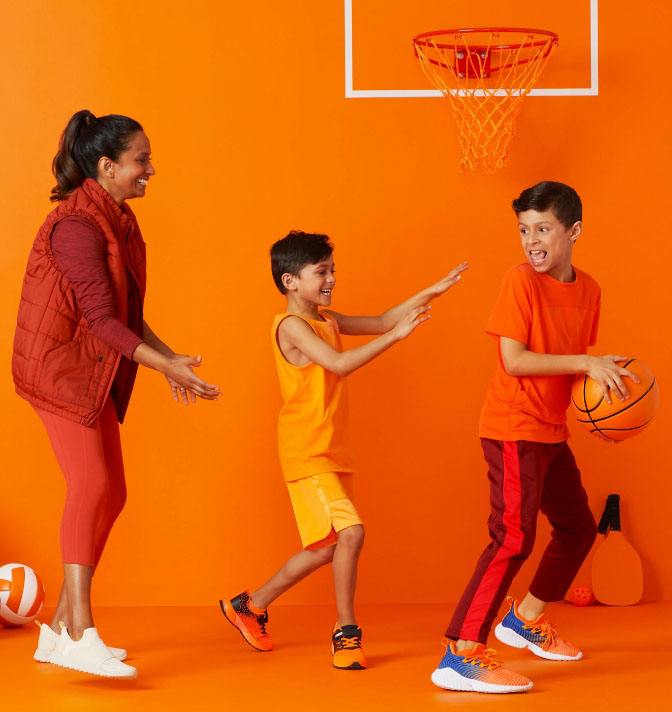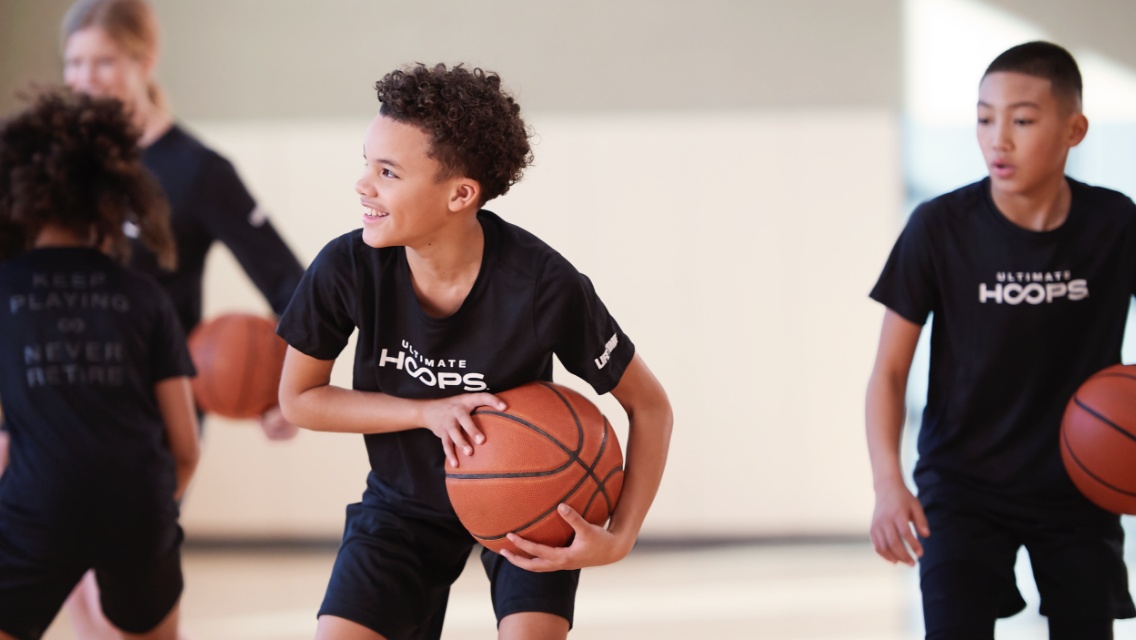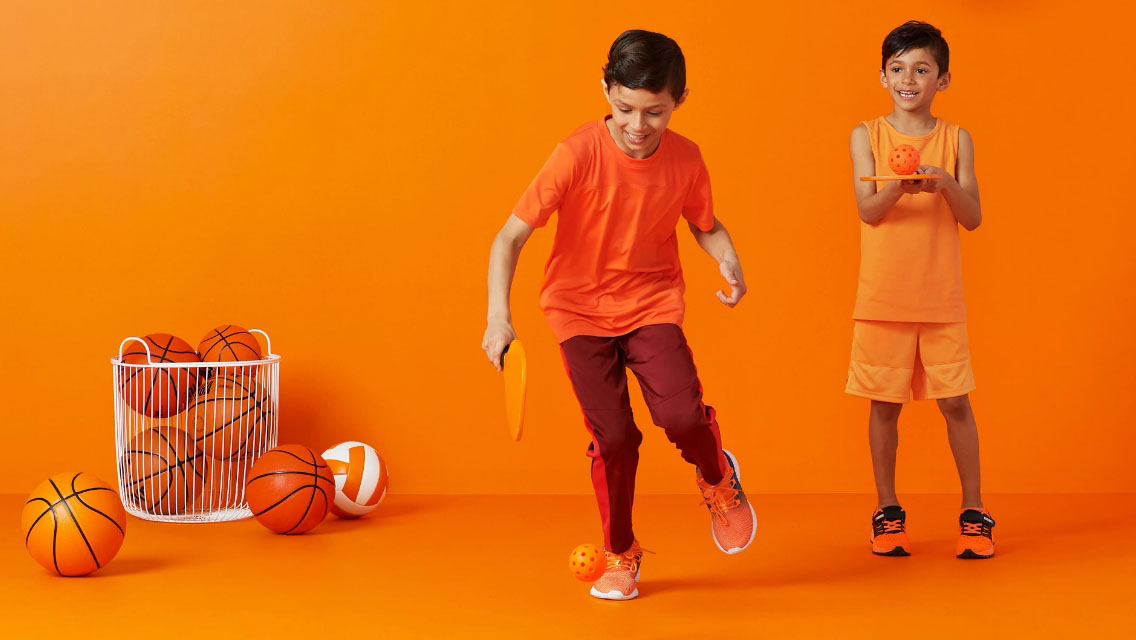Summertime is technically the off-season for basketball — but it’s the best time to work on your game, according to Adrian Woodard, lead basketball trainer at Life Time in Bergen County, N.J.
“There’s immense value in working on your basketball skills in the summer months,” says Woodard. “Most players have more time to practice — especially if they’re kids or young adults who are free from school — and can spend time away from their team to grow their individual game. I always say to the athletes I train: ‘Summertime grind for winter shine.’”
Start leveling up your basketball skills this season with these six tips for enhancing your game from Woodard.
1. Create a weekly routine and stick to it.
Woodard recommends your weekly routine include a mix of the following:
- Skills training: Fine-tune your ball handling, shooting drills, and finishing around the basket.
- Performance training: Work on strength training and cardio for conditioning and stamina on the court.
- Watching film and IQ development: Learn how to make better real-time decisions on the court.
- Game playing: Test out what you’ve been working on and put it into play.
“However you choose to integrate each of these elements into your routine, make sure to take a rest day,” Woodard advises. “I like to use Sundays for recovery.”
2. Identify two main improvement goals.
Woodard recommends selecting two aspects of your game to focus on improving throughout the off-season. For example, you could choose to work on three-pointers, free throws, or ball handling — any two skills that will make the biggest difference for your individual game.
“I recommend dedicating 60 percent of your skill-work training sessions to these goals, says Woodard. “The other 40 percent can be spent practicing and maintaining what you already do well.”
3. Track your progress.
Arguably the most important aspect of your summer development plan is recording your progress. “I tell my players to record everything in a journal or on a note in their phone,” says Woodard. “That way you can see growth and development in your game, skills, and performance. Week by week, you can see how to progress by increasing your number of shots made, for example, or increasing weight as you get stronger.
“If you shot 500 shots and made 350 of them, write it down. If you worked out and used 15-pound dumbbells for triceps for three sets of 10 reps, record it. Or if you watched 30 minutes of film from the NBA, WNBA, NCAA or your own game, journal it. Your future self will thank you — and you’ll know exactly how you achieved your goals.”
4. Remember the importance of rest and relaxation.
Along with being physical, basketball is an extremely mental sport. “As athletes sharpen their skills on the court, they must also take time to relax and calm their mind and body as all this vigorous work can take a toll,” Woodard adds. “Meditation is a great tool to reset your thoughts. It helps you to dwell less on your failures and perfection so you can simply do the work you need to improve. It can also help you prepare for another tough day or week of training.”
5. Attend a clinic or work with a coach.
Working with a coach or peers can provide opportunities to take your game to the next level that you may not otherwise be able to do on your own.
“I highly recommend attending a camp or clinic or working with a coach or trainer in the summer,” says Woodard. “At camps or clinics, you can compete against your peers and see how your game stacks up. It’s immediate feedback to let you know what you do well, what you need to work on, and where you stand when it comes to local competition.
“Additionally, having a coach or trainer is like having a tutor for basketball,” he adds. “They can help you increase your basketball IQ by teaching you new skills and drills to develop your instincts on the court. Those who seek extra help will thrive more during the season.”
Life Time’s Ultimate Hoops summer camps offer a combination of basketball and fun for all ages, with knowledgeable trainers who are dedicated to creating better players.
6. Join a summer league.
If you want to become a better basketball player, the more game-time experience you have, the better.
“Joining a summer league is another way to test out your skills against the local competition,” Woodard points out. “Skill work, camps, and workouts are all great, but in-game competition is one of the best ways to learn and improve your game. It’s also a good way to make connections, meet new people, and build lifelong friendships.”
2 Summer Basketball Shooting Drills
1. Ladder Form
This drill improves your shooting form by having you practice different footwork and shooting from several distances from the basket. It works best with two people: a shooter and a rebounder.
- Start out standing directly in front of the basket, about two feet away.
- Shoot the ball and continue shooting until you make 25 baskets. The shot only counts if it goes directly through the net without touching the rim or backboard.
- After 25 makes, step farther away from the basket, stopping somewhere in the middle of the paint. Shoot until you make 20 shots.
- Move back to the free-throw line area and shoot until you make 15 shots.
- Move back to the three-point line and shoot until you make 10 shots.
Optional Footwork:
Add in different footwork options to mimic game situations.
- Take one or two steps forward, backward, or to the side before your shoot.
- Add one or two dribbles before you shoot.
2. Around-the-World
This drill focuses on shooting efficiency from a variety of spots on the court. It works best with two people: a shooter and a rebounder.
- Set five spots (mark them with tape or cones, if needed) on the arc of the three-point line — one at each of the two corners, at the two wings, and one at the top of the key.
- You must make one three-pointer at each spot, starting at one end, going around the arc, and then back again (10 total makes). Then, you must make a free-throw.
- Start the drill over, but this time, you must make two shots at each spot.
- Start over again, and this time you must make three shots at each spot.
- Record how many three-pointers and free-throws you make and take from each spot to keep track of your progress for next time.
Optional modifications:
- Set a time limit or number of chances at each spot.
- Adjust to a mid-range distance for a younger player.





